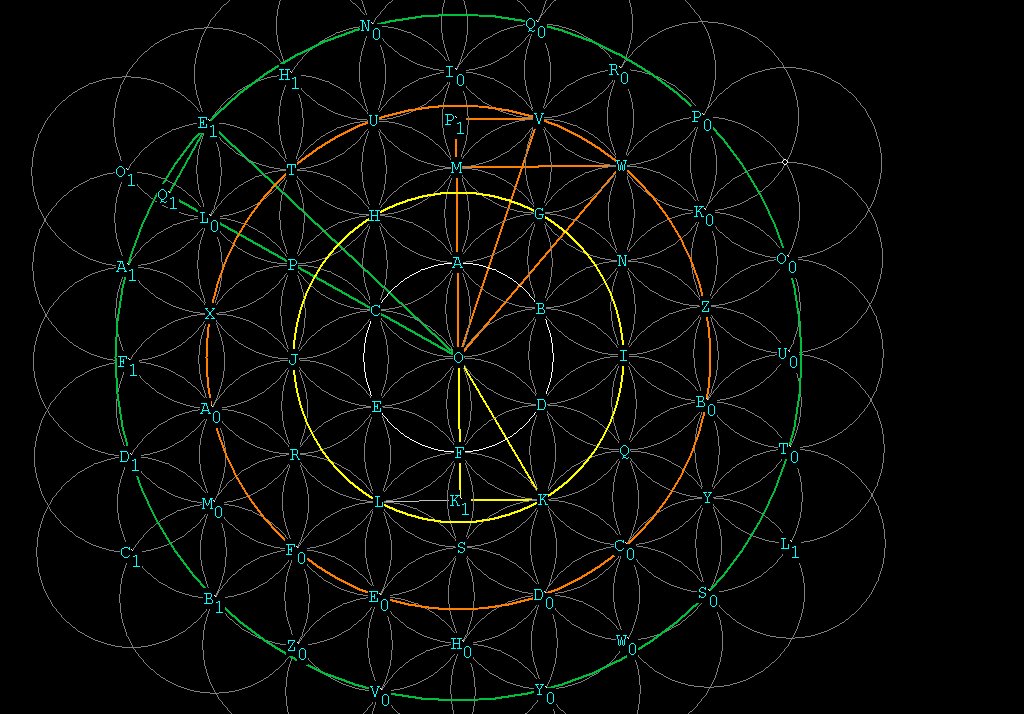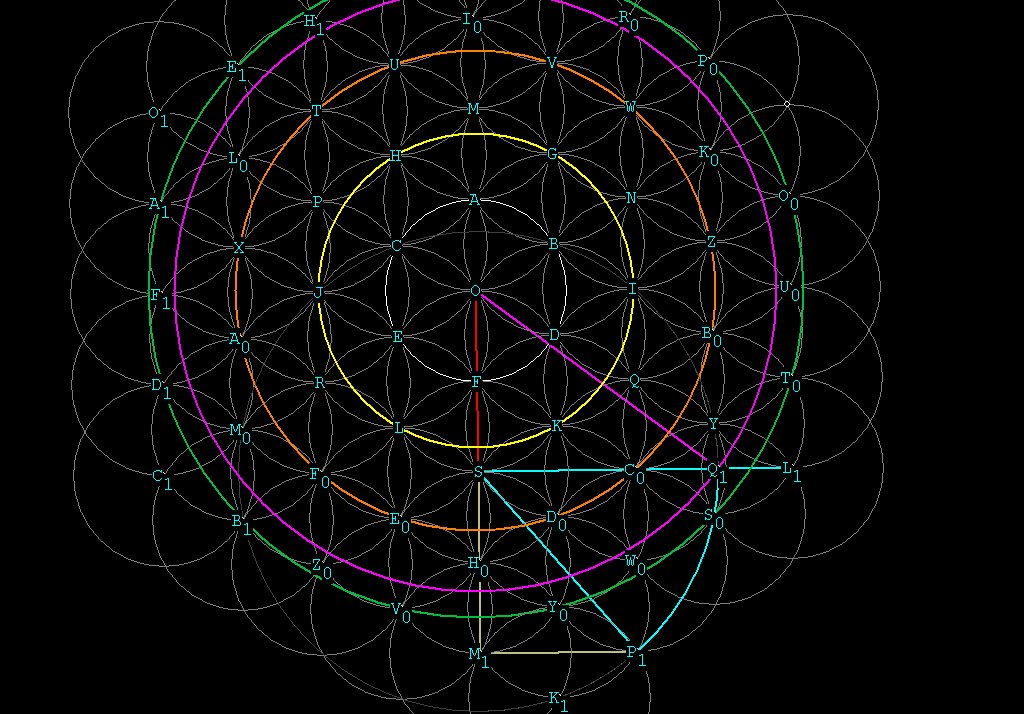
We will use the intersecting circle/sphere pattern to
construct
roots.
We will do this using simple right triangles.
The determination of the roots in this manner is geometrically
precise.
The determination of a root can be done almost by eyeballing the
pattern.
Using this pattern, the easiest roots to construct, I have found, are
the prime roots!
\/¯3 and \/¯7 figure prominently in the construction of
roots,
believe it or not.
The construction of higher and higher roots is made simpler by the
use of roots lower in the table.
This paper will present the basic concept and show it with
diagrams
.
Now please read " Introduction To The
Pattern ."
Following is a table showing how to construct roots.
As we go higher and higher in the table, there are more and more ways
to construct roots using the pattern. No doubt others will find more
elegant
ways to do so than are provided in the table.
1 = one radial distance in the pattern. For example, OB = 1.
| root | alt | alt | ||||
| (hypotenuse) | side 1 | side 2 | side 1 | side 2 | ||
| 2 | 1 | 1 | ||||
| 3 | 1 ½ | \/¯3 / 2 | ||||
| 4 | 2 | 0 | 1 | \/¯3 | ||
| 5 | 2 | 1 | ||||
| 6 | 2 | \/¯2 | ||||
| 7 | 2 ½ (2) | \/¯3 / 2 (\/¯3) | ||||
| 8 | 2 | 2 | 1 | \/¯7 | ||
| 9 | 3 | 0 | \/¯2 | \/¯7 | ||
| 10 | 3 | 1 | ||||
| 11 | 2 | \/¯7 | 3 | \/¯2 | ||
| 12 | 3 | \/¯3 | ||||
| 13 | 3 ½ | \/¯3 / 2 | ||||
| 14 | \/¯7 | \/¯7 | 2 | \/¯10 | ||
| 15 | 2 | \/¯11 | ||||
| 16 | 3 | \/¯7 | ||||
| 17 | 4 | 1 | ||||
| 18 | 3 | 3 | ||||
| 19 | 4 | \/¯3 | ||||
| 20 | \/¯10 | \/¯10 | ||||
| 21 | 4 ½ | \/¯3 / 2 | ||||
| 22 | 3 | \/¯13 | ||||
| 23 | 4 | \/¯7 | ||||
| 24 | ||||||
| 25 | 5 | 0 | ||||
| 26 | ||||||
| 27 | 5 | 1 | ||||
| 28 | ||||||
| 29 | 5 | 2 | ||||
| 30 | ||||||
| 31 | 5 ½ | \/¯3 / 2 | ||||
| 32 | 5 | \/¯7 | ||||
The way to go about the determination of the root is as follows:
Pick any point in the pattern. I usually start from the center of a
circle, but this is not required.
Get side 1 by going in any of the 6 directions indicated by the pattern
and determining point 1.
Get side 2 by going at a right angle the necessary distance and finding
point 2.
Connect your origin point to point 2 to find the hypotenuse. Draw a
circle with radius equal to the hypotenuse. All points on this circle
are
the root distance from point of origin.
I will demonstrate the determination of the \/¯3, \/¯7,
\/¯13.

\/¯3:
The Table shows \/¯3, side 1 = 1 1/2, side2 = \/¯3 / 2.
Start at O. Go 1 to F and then 1/2 more to find point K1. Now take
a right angle and go
1/2 the distance along the large \/¯3 vesica LK, from K1 to K.
Now simply connect OK and draw a circle with center at O. I have
marked this circle in yellow.
Notice that \/¯3 hits all of the vesica endpoints at L,J,H,G
and I.
\/¯7:
The table shows \/¯7, side 1 = 2 1/2, side 2 = \/¯3 / 2..
Or,
side 1 = 2 , side 2 = \/¯3.
Start at O. Go 2 to M and then 1/2 more to P1. Take a right angle
\/¯3
/ 2 and hit V.
Connect OV and draw circle.
Or, go 2 to M and \/¯3 to W, covering the entire \/¯3 vesica
MW.
Connect OW to get the same circle.
Notice that \/¯7 fits elegantly into the pattern, hitting all
vesica points at Z,W,V,U,T,X, etc.
\/¯13:
Start at O. Go 3 radial distances until you hit Lo, the 1/2 more to
hit Q1.
Take a right angle from Q1 to hit E1. Connect OE1 and you have a circle
with radius \/¯13.
Notice that again, \/¯13 elegantly hits vesica points at E1, A1,
D1, etc.
The roots which fit most elegantly into the pattern are those which
can be directly determined from the \/¯3.
Astonishingly ALL of the roots, prime or not, may be geometrically
determined using the \/¯3.
This gets fun when you try more difficult roots.

For instance, to get \/¯11, the table says to go 2 radial
distances,
to S, then at right angles a distance equal to \/¯7. This
sounds
ludicrous until you try it!
\/¯7 elegantly fits into the pattern. Look up \/¯7 and you
find it is just (2,\/¯3).
All you have to do is from S in which you went 2 radial distances,
make a right triangle by going 2 more radial distances to M1 and then
at
right angles to that, go \/¯3 to P1. Connect up SP1 and you have
\/¯7!
I have highlighted SP1 in cyan. If you are using compass and
straightedge,
pin your compass at S with length SP1 and draw an arc to intersect the
line SL1, which is perpendicular to SM1 and thus at a right angle to
SM1.
You will hit Q1.
SQ1 = \/¯7, at a right angle to OS and forming the long
side of a right triangle OSQ1.
Now connect OQ1 and you have \/¯11! A circle has been drawn
in magenta to represent the \/¯11.
Determining and graphing square roots is amost trivial using this method.
The prime roots seem to be easier to graph and calculate than the
others!
For example the \/¯19 requires one right triangle, but the
\/¯20
requires two.
That is because the pattern is based on the \/¯3, which is
friendlier
to 19 than to 20.
Nevertheless, this method is a powerful (and fun!) way to graph any
root.
Here are some interesting tidbits:
The relationship between Ø and the \/¯3:
The Missing
Link: The Ø to \/¯3 Conversion Triangle
Some earlier thoughts on square roots
The Square
Root of 7
Special characters:
\/¯ ° ¹ ² ³ × ½
¼
Ø \/¯(ز + 1)